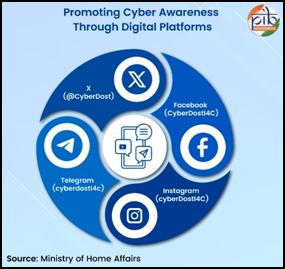India has taken a major leap in digital security with the launch of the “Curbing Cyber Frauds in Digital India” initiative — a nationwide effort to harness Artificial Intelligence (AI) and Machine Learning (ML) for detecting and preventing cybercrimes in real time.
The programme, announced by the Government of India, comes at a time when cybercrime is rising at an alarming pace. According to official data from CERT-In, cyber fraud complaints have more than doubled — from 1.02 million in 2022 to 2.26 million in 2024. Authorities believe that AI-driven surveillance and early-warning systems could help stop financial frauds before they occur.
AI-Powered Defence Network
At the heart of the plan is an AI-ML powered engine that will automatically flag suspicious transactions and alert banks, telecom providers, and law enforcement simultaneously — preventing money from being siphoned off.
A senior government official explained,
“The AI system will detect unusual behavioural patterns in digital payments — like rapid microtransactions, mismatched devices, or irregular location pings — and issue automated alerts for immediate action.”
Developed jointly by MeitY, the Reserve Bank of India (RBI), and the Department of Telecommunications (DoT), the platform aims to unify cyber vigilance across India’s digital ecosystem.
Integrated Response System
The initiative will be integrated with the National Cybercrime Helpline (1930) and cybercrime.gov.in, enabling seamless complaint tracking and instant coordination between victims, banks, and police units. This will reduce response times from days to minutes — a game-changer in financial fraud prevention.
Officials said the goal is to create a “real-time protection loop” that connects citizens, service providers, and enforcement agencies in one dynamic cyber safety grid.
Crackdown on Fake SIMs and Devices
In tandem with the AI rollout, the government has intensified its crackdown on digital fraud enablers. Over 9.42 lakh SIM cards and 2.63 lakh fake IMEI numbers linked to scam networks have already been deactivated.
Telecom officials said these measures are “cleaning up India’s digital backbone” and reducing the operational networks of fraud syndicates before the AI system becomes fully operational nationwide.
Empowering India’s Cyber Police
Technology alone isn’t enough — and the government knows it. Through the ‘CyTrain’ programme, over 1.05 lakh police officers have been trained in cyber forensics, data recovery, and digital evidence handling.
Recent policy frameworks, including the Digital Personal Data Protection Act, 2023, have further reinforced accountability and citizen privacy in India’s cyber governance.
Expert Insight: A Shift from Reactive to Preventive Policing
Cybercrime expert and former IPS officer Prof. Triveni Singh hailed the initiative as a “landmark moment in India’s cyber policing evolution.”
“Cyber fraud today is organized, cross-border, and highly sophisticated. The use of AI and ML will help India move from reactive response to predictive policing — spotting fraud patterns before they strike,” Prof. Singh said.
He emphasized the need for banks, fintechs, and law enforcement to collaborate on a shared data intelligence network — calling it “essential for the AI ecosystem to succeed.”

Five Key Safety Reminders for Citizens
1. Never share OTPs, passwords, or UPI PINs with anyone.
2. Install apps only from verified app stores.
3. Enable Two-Factor Authentication (2FA) on all digital accounts.
4. Report frauds immediately via 1930 or cybercrime.gov.in.
5. Regularly review app permissions and privacy settings.
Building a Digitally Secure India
With 86% of Indian households now connected to the internet, the “Curbing Cyber Frauds in Digital India” initiative reflects a national commitment to digital trust and citizen protection.
If implemented effectively, experts believe it could make India a global leader in AI-driven cybersecurity — transforming the nation from one of the biggest digital economies into one of the safest.


